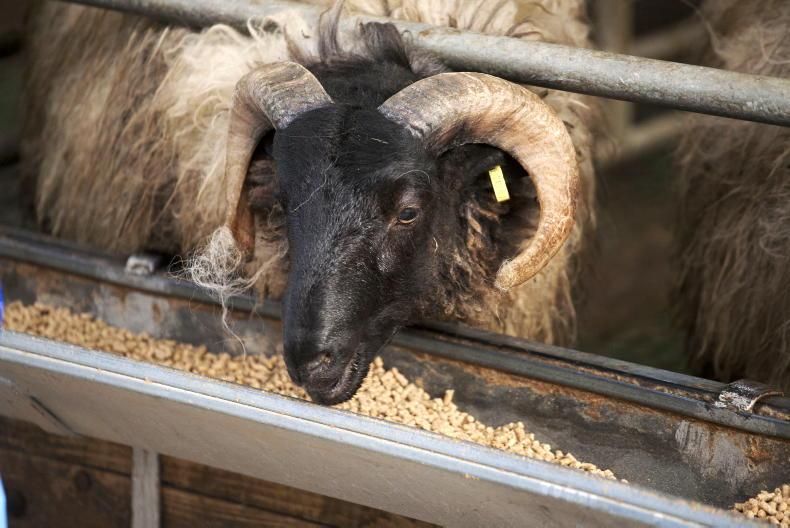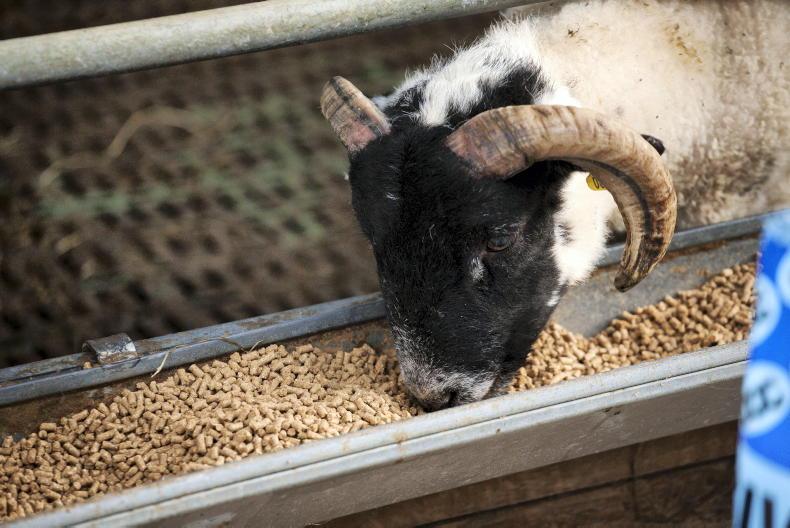The relatively clement weather this autumn and positive grass supplies is delaying housing of lambs that may in a normal year be housed by now or in the coming weeks.
There have been comments made by some farmers that they could possibly hold off in introducing concentrates in light of their increased cost, while others have raised some queries around the potential of finishing lambs on a combination of silage/hay and concentrates. 
Looking at the latter point first, research carried out in Teagasc Athenry has shown that feeding medium feed-value grass silage of approximately 70% dry matter digestibility (DMD) and low feed-value silage has no role in finishing lambs other than possibly acting as a roughage source on an intensive concentrate diet.
There is a possible role in feeding high feed-value silage of 75% DMD plus, but silage of this quality is not frequently found on many farms and, even if it is, at current concentrate costs there is still a much higher margin over feed costs from feeding a concentrate-based diet.
Targeted feeding
One area which will help to improve the returns from finishing lambs intensively is targeting feed to lambs that will deliver the best economic return.
This is typically lambs which have been allowed to mature and develop a frame and, in turn, will quickly finish to French carcase weights.

This is particularly relevant to hill lambs of Scottish Blackface and Cheviot breeding.
Current grass supplies is providing an opportunity to store lambs on grazed grass and develop a frame at a lower cost.
Teagasc research shows that lowland terminal-sired lambs grazing good-quality grass with good levels of grass utilisation will gain in the region of 115g/day (0.8kg/week) during October and November, reducing to less than 50g per day in December and January.
For hill lambs, this can reduce to 60g/day or just 0.4kg/week in October and November.
This can be increased to 100g daily by offering concentrate supplementation at a rate of 300g daily with a conversion of 6kg to 9kg concentrates to 1kg liveweight gain.
Intensive finishing
Once lambs are transferred to an intensive finishing diet performance will quickly increase, but so too will intake levels highlighting the importance of lamb selection and regular drafting.
Research shows light Scottish Blackface lambs (25kg to 30kg) will gain in the region of 200g daily from an intake averaging 1.2kg to 1.25kg concentrates, while performance of continental crosses is in the region of 230g to 280g from an average intake of 1.26kg to 1.3kg concentrate over 60 to 65 days of feeding.
Heavier Scottish Blackface lambs (36kg to 37kg) have the potential to gain in the region of 220g (wethers) to 250g (rams) from a feed intake averaging 1.4kg over five weeks of feeding. Research shows that Texel x Scottish Blackface lambs of similar weight capable of achieving excellent weight gain of 315g (wethers) to 365g daily over the same finishing period. Intake, however, is significantly higher at 1.6kg to 1.66kg concentrates daily.
Performance variance
Significant variation in lamb performance has been seen in all recent finishing trials in Athenry, much of which is attributed to intake levels.
Individual lambs with high intakes of 1.8kg to 2kg can perform at close to 450g to 500g per day reinforcing the importance of getting the finishing programme right and regular drafting.
Well-grown lambs in the finishing phase will not benefit from dietary crude protein levels above 11% or 12%
While lambs consuming less than 1kg concentrates can gain as low as 100g and may need to be segregated for preferential treatment.
In terms of feed formulation the advice is that growing lambs (less than 35kg) have an additional requirement for protein and should receive a diet containing 13% to 14% crude protein. Well-grown lambs in the finishing phase will not benefit from dietary crude protein levels above 11% or 12%.
Concentrate diets will deliver the highest level of performance and margin over feed costs.Targeting concentrates to lambs which will deliver the best response will improve the economics of finishing.Intensive finishing diets have the potential for high levels of performance but intake levels can quickly accumulate.Lambs should be weighed and drafted regularly.
The relatively clement weather this autumn and positive grass supplies is delaying housing of lambs that may in a normal year be housed by now or in the coming weeks.
There have been comments made by some farmers that they could possibly hold off in introducing concentrates in light of their increased cost, while others have raised some queries around the potential of finishing lambs on a combination of silage/hay and concentrates. 
Looking at the latter point first, research carried out in Teagasc Athenry has shown that feeding medium feed-value grass silage of approximately 70% dry matter digestibility (DMD) and low feed-value silage has no role in finishing lambs other than possibly acting as a roughage source on an intensive concentrate diet.
There is a possible role in feeding high feed-value silage of 75% DMD plus, but silage of this quality is not frequently found on many farms and, even if it is, at current concentrate costs there is still a much higher margin over feed costs from feeding a concentrate-based diet.
Targeted feeding
One area which will help to improve the returns from finishing lambs intensively is targeting feed to lambs that will deliver the best economic return.
This is typically lambs which have been allowed to mature and develop a frame and, in turn, will quickly finish to French carcase weights.

This is particularly relevant to hill lambs of Scottish Blackface and Cheviot breeding.
Current grass supplies is providing an opportunity to store lambs on grazed grass and develop a frame at a lower cost.
Teagasc research shows that lowland terminal-sired lambs grazing good-quality grass with good levels of grass utilisation will gain in the region of 115g/day (0.8kg/week) during October and November, reducing to less than 50g per day in December and January.
For hill lambs, this can reduce to 60g/day or just 0.4kg/week in October and November.
This can be increased to 100g daily by offering concentrate supplementation at a rate of 300g daily with a conversion of 6kg to 9kg concentrates to 1kg liveweight gain.
Intensive finishing
Once lambs are transferred to an intensive finishing diet performance will quickly increase, but so too will intake levels highlighting the importance of lamb selection and regular drafting.
Research shows light Scottish Blackface lambs (25kg to 30kg) will gain in the region of 200g daily from an intake averaging 1.2kg to 1.25kg concentrates, while performance of continental crosses is in the region of 230g to 280g from an average intake of 1.26kg to 1.3kg concentrate over 60 to 65 days of feeding.
Heavier Scottish Blackface lambs (36kg to 37kg) have the potential to gain in the region of 220g (wethers) to 250g (rams) from a feed intake averaging 1.4kg over five weeks of feeding. Research shows that Texel x Scottish Blackface lambs of similar weight capable of achieving excellent weight gain of 315g (wethers) to 365g daily over the same finishing period. Intake, however, is significantly higher at 1.6kg to 1.66kg concentrates daily.
Performance variance
Significant variation in lamb performance has been seen in all recent finishing trials in Athenry, much of which is attributed to intake levels.
Individual lambs with high intakes of 1.8kg to 2kg can perform at close to 450g to 500g per day reinforcing the importance of getting the finishing programme right and regular drafting.
Well-grown lambs in the finishing phase will not benefit from dietary crude protein levels above 11% or 12%
While lambs consuming less than 1kg concentrates can gain as low as 100g and may need to be segregated for preferential treatment.
In terms of feed formulation the advice is that growing lambs (less than 35kg) have an additional requirement for protein and should receive a diet containing 13% to 14% crude protein. Well-grown lambs in the finishing phase will not benefit from dietary crude protein levels above 11% or 12%.
Concentrate diets will deliver the highest level of performance and margin over feed costs.Targeting concentrates to lambs which will deliver the best response will improve the economics of finishing.Intensive finishing diets have the potential for high levels of performance but intake levels can quickly accumulate.Lambs should be weighed and drafted regularly. 







 This is a subscriber-only article
This is a subscriber-only article











SHARING OPTIONS: